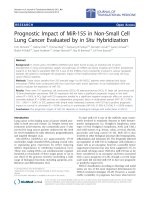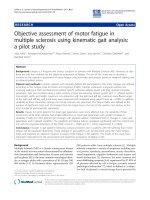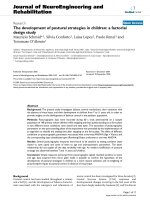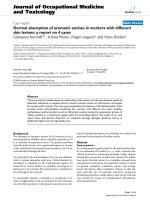báo cáo hóa học: " Reduced inclination of cervical spine in a novel notebook screen system - implications for rehabilitation" docx
Bạn đang xem bản rút gọn của tài liệu. Xem và tải ngay bản đầy đủ của tài liệu tại đây (2.07 MB, 6 trang )
RESEARCH Open Access
Reduced inclination of cervical spine in a novel
notebook screen system - implications for
rehabilitation
David Quarcoo
1*
, Cristian Scutaru
1,2
, Ulrich Henkel
1
, Michael F Spallek
1
, Stefanie Uibel
1
, Karin Vitzthum
1
,
Stefanie Mache
1
, Bianca Kusma
1
and David A Groneberg
1
Abstract
Background: Professional working at computer notebooks is associated with high requirements on the body
posture in the seated position. By the high continuous static muscle stress resulting from this position at
notebooks, professionals frequently working at notebooks for long hours are exposed to an increased risk of
musculoskeletal complaints. Especially in subjects with back pain, new notebooks should be evaluated with a focus
on rehabilitative issues.
Methods: In a field study a new notebook design with adjustable screen was analyzed and compared to standard
notebook position.
Results: There are highly significant differences in the visual axis of individuals who ar e seated in the novel
notebook position in comparison to the standard position. Also, differences are present between further alternative
notebook positions. Testing of gender and glasses did not reveal influences.
Conclusion: This study demonstrates that notebooks with adjustable screen may be used to improve the posture.
Future studies may focus on patients with musculoskeletal diseases.
Introduction
Over the past centuries a profound change in the work
reality of most citizens has happened worldwide. In
Europe at th e end of the 19
th
century great parts of
the workforce was employed in the agriculture a nd
producing sector [1]. Today these sectors cease impor-
tance in regard to the people employed while the ser-
vice and information industries have gained
importance [1]. Here the typical work environment is
the workstation. Although the fading away of the
heavy and dirty work lead to an exoneration of health
risks new work related health challenges have
appeared. Above all the psychological and ergon omic
burden of work gets into the focus of interest [2]. The
physical strain of the office work relates to the muscu-
loskeletal system which centers on the shoulder/arm
and cervical and lumbar region [3]. Local strain in the
musculoskeletal system can be relayed to distant sites,
resulting in complains in further regions. Diseases of
the musculoskeletal system are a frequent cause of
work related morbidity. In a recent survey of the Fed-
eral Institute for Occupational Safety and Health 46,2%
of the total workforce experienced shoulder neck pain,
of which 61% lead to medical consultation [4]. The
study identified declination of the cervical spine a risk
factor next to forced posture and hard labor. In this
line detailed specifications have bee n worked out to
minimize work related adverse effects at these work-
places. In Germany extended research has lead to a
national regulation for w orkstation (BildscharbV) that
defines the workstation delineating sizes of chair and
table to guarantee optimal body and visual axis [5].
This approach introduced a (average) body size inde-
pendent evaluation of the workplace (Figure 1).
* Correspondence:
1
Institute of Occupational Medicine, Charité - Universitätsmedizin Berlin, Free
University and Humboldt University, D-14195 Berlin, Germany
Full list of author information is available at the end of the article
Quarcoo et al. Journal of Occupational Medicine and Toxicology 2011, 6:30
/>© 2011 Quarcoo et al; licensee BioMed Central Ltd. This is an Ope n Access article distributed under the terms of th e C reative
Commons Attribution License ( enses/by/2.0), which permits unrestricte d use, distribution, and
reproduction in any medium, provided the original work is pr operly cited.
The increasing mobility together with growing work
intensification results in the desire to use traveling time
to continue computer based work. Ther efore the
amount of mobile computer units such as notebooks
etc. has increased over time [6]. Owing to the compact
design these units do not comply with above mentioned
guide lines. Docking station and extern keypads might
all eviate some concerns but the problem of an unfavor-
able visual axis remains.
Owing to the difficult ergonomic situation notebooks
might easily become a hindrance for productivity and a
potential problem for the well being and health [7].
Recently this problem was addressed by the novel
design of th e notebook lid that allows the extension of
the screen in a vertical plane. The concept envisions
that in operation modus the screen is lifted various
steps upwards and locked in place to allow a more
extended position of the cervical spine.
Theaimofthecurrentstudywastoanalyzecharac-
teristics of a note book with a variable extended screen
system. We hypothesize that the new system leads to a
lower degree of inclination and may therefore serve for
rehabilitative issues
Materials and methods
Study population
Healthy probands were recruited by public no tice. Infor-
mation on health was collected by questionnaire. Thirty
test persons with written consent, fulfilling the criteria
were selected into the study. The subjects’ anthropometric
characteristics are presented in detail in Table 1. The pri-
mary inclusion criterion for the study was no severe dis-
ease or trauma of the m usculoskeletal system. Other
inclusion criteria were age between 20 and 60 years.
Determination of cervical flexion
Subjects were positioned on aheightadjustableoffice
chair and desk in co mpliance with the national guideline
for workstations. The inclination of the cervical spine was
measured in diffe rent positions in reference to the visual
Figure 1 Postural requirements according to the national regulation for workstation (BildscharbV).
Table 1 Anthropomorphic data of test persons
Gender Average
age
Average
height
Average
weight
Corrective
lenses
Female 32.50 y. 169.25 cm 62.00 kg 12/30
Male 31.22 y. 184.0 cm6 84.28 kg 18/30
Quarcoo et al. Journal of Occupational Medicine and Toxicology 2011, 6:30
/>Page 2 of 6
axis using an a daptable protract or mounted on a stand
(Figure 2). When determining the inclination, the test
operator verified the eye position to be in an intra-study
comparable middle position. After a position with straight
visual axis, position of the computer screen was adjus ted
according to a test routine described in Table 2 and incli-
nation of the cervical spine was measured. A notebook
with 15 inch screen was used. Digital photo overlay tech-
niques were applied to compare the positions (Figure 3).
Ethics
The local ethics committee approved the study and the
participants gave their informed written consent prior to
inclusion in the study.
Statistics
Results are expressed as means with standard deviations
(SD). Due to the small sample size non-parametric
methods were used, because they are more robust. F
was used instead of the chi-square distribution if the
frequencies were too low (more than 20% of the cells
had an expected count less than 5) to avoid type II
errors. A p-value of less than .05 was consider ed signifi-
cant. Analyses were performed using SPSS version 17.0.
Results
Optical measurements
The inclination was determined using optical measure-
ments. To verify the results a photo digital overlay
technique was used that demonstrated substantial differ-
ences in the various positions (Figure 3).
Cervical inclination in different positions
All test persons were measured in all 5 positions (Figure
4). The cervical inclination was 90,3° in the position 0,
85,03° in position 1, 80,4° in position 2, 75,5° in position
3 und 71,53° in Position 4 (Figure 4). The statistical ana-
lysis resulted in significant differences between the dif-
ferent positions 0-4 (Table 3).
Gender influence on cervical inclination
The influence of gender was determined for the 5 posi-
tions (Figure 4). We found that men (18) had a cervical
inclination of 90,06° in Position 0, 84,44° in position 1,
79,61° in position 2, 74,78° in position 3 und 70,61° in
Figure 2 Study set-up. The workstation with adjustable ergonomic
chair and desk as well as the adaptable protractor are displayed.
Table 2 Different experimental positions
Position 0 Straight visual axis, without gazing to the computer
screen.
Position 1 Maximal extension of computer screen (38 cm upper
edge of screen)
Position 2 Second extension of computer screen (33 cm upper
edge of screen)
Position 3 Second extension of computer screen (31 cm upper
edge of screen)
Position 4 Common notebook screen position (27 cm upper
edge of screen)
Figure 3 Optic al measurement of the visua l axis in photo
digital overlay technique.
Quarcoo et al. Journal of Occupational Medicine and Toxicology 2011, 6:30
/>Page 3 of 6
posit ion 4 (Figure 5). The inclination in female test per-
sons (12) was 90,67° in position 0, 8 5,92° in position 1,
81,58° in position 2, 76,58° in position 3 und 72,92° in
position 4. As for the total test population a difference
was found within a gender group between positions.
The gender group did not differ significantly in each of
the positions.
Influence of corrective lenses on cervical inclination
The influence of the usage of corrective lenses on the
cervical inclination was investigated for all 5 positions.
The average inclination of subjects without corrective
lenses was 90,35° in position 0, 85,53° in position 1,
80,88° in position 2, 76,29° in position 3 und 71,82° in
position 4 (Figure 6). The data for probands with cor-
rective glasses (13) demonstrated a c ervical inclination
of 90,23° in position 0, 84,38° in position 1, 79,77° in
position 2, 74,46° in position 3 und 71,15° in posit ion 4.
There was no significant difference between the two
groups in each of the positions.
Discussion
The increasing mobile use of notebooks poses a proble-
matic ergonomic situation. To circumvent some of the
negative effects on the musc uloskeletal system that
occurs with the unfavorable body position a novel
screen system was designed. This height adjustable dis-
play was evaluated in the current study. The cervical
inclination that corresponded to the five position of the
computer display differed significant in all subjects
resultinginareducedflexioninthemaximummoved
out position.
The vertical strain on the spine is reflected by the force
that acts on t he intravertebral discs that lead to changes
in the intradiscal pressure (PID). It has been suggested
that an increased PID may worsen the alime ntary status
of the in travertebral disc that might contribute to a faster
advancing of degener ative processes [8-10]. Studying the
lumbar spinal region Nachemson an d coworker demon-
strated that different body postures influence the intra-
discal pressure [11,12]. The results were confirmed by
data from discography and chemonucleolysis [10]. There
are important differences between the sections of the
spine. In cervical discs, the nucleus is less able to equalize
stress over large distances, and the posterior annulus
does not sustain high compressive stresses [13]. Although
most research focused on the lumbar spine, recent data
has found a postural dependence also for the cervical
spine [8,9]. PID is lowest in the middle position between
flexion and extension [9]. This relation has found expres-
sion in national guidelines where an only marginal flex-
ion of the neck with the least stress is favored for the
working environment.
Next we evaluated factors that might influence the
extent of inclination. In this context Nightingale and
Figure 4 Cervical inclination in different positions. The cervical inclination o f all individuals (n = 30) is depicted in the different screen
positions. Significances are displayed in Table. 3.
Table 3 Differences between the experimental positions
Position
0
Position
1
Position
2
Position
3
Position
4
Position
0
XXXXX
Position
1
= 1.7* XXXX
Position
2
= 1,6 = 2.2 X X X
Position
3
= 1,9 = 2.5 = 2.8** X X
Position
4
= 1.8 = 2.6** = 2.7** = 2.9* X
*p < 0.05, **p < 0.01
Quarcoo et al. Journal of Occupational Medicine and Toxicology 2011, 6:30
/>Page 4 of 6
coworker have found gender specific anatomic differ-
ences of the cervical spine. The male upper cervical
spine is significantly stiffer and stronger [14]. In our
study population there was no difference between the
neck inclination of the male and female subjects.
Also for another possible influencing factor - the
wearing of correction lenses - no distinction was found,
supporting the relevance of the data.
In summary the moved out position of a new height
adjustable notebook display reduces significantly the
cervical inclination. From data that the vertical strain on
the cervical spine depends on the degree of inclination,
it may be assumed that in this position the strain is
reduced. The novel screen advances the notebook dis-
play ergonomically next to desktops. It may be especially
beneficial in rehabilitation.
Future studies will evaluate the novel displays’ ability
to reverse already set in damages of the musculoskeletal
system. Furthermore the influence on the upper body
and the position of the keyboard will be future research
topics.
Conflict of interests
This study was funded by Dreamcom Deutschland
GmbH. The view s in this article are the personal views
of the authors and do not necessarily represent the
Figure 5 Influence of gender. The cervical inclination of female and male individuals is depicted in the different screen positions.
Figure 6 Influence of correction lenses. The cervical inclination individuals with/without correction lenses is depicted in the different screen
positions.
Quarcoo et al. Journal of Occupational Medicine and Toxicology 2011, 6:30
/>Page 5 of 6
views of the professional orga nizations or institutions
within which we are members.
Acknowledgements
The authors would like to thank I. Kölzow for excellent technical support
and all individuals who participated in the study as subjects.
Author details
1
Institute of Occupational Medicine, Charité - Universitätsmedizin Berlin, Free
University and Humboldt University, D-14195 Berlin, Germany.
2
Department
of Respiratory Medicine, Hannover Medical School, Hannover, Germany.
Authors’ contributions
DAG, UH and DQ drafted the manuscript. DAG, CS, UH and DQ conceived
the study and the study design, performed the analysis and interpretation of
the data. MFS, SU, KV, SM, BK: Participation in the analysis of data, revision of
the manuscript. All authors read and approved the final manuscript.
Received: 28 May 2010 Accepted: 25 November 2011
Published: 25 November 2011
References
1. Rürup BS: Werner Wirtschafts- und Arbeitswelt. In Deutschland Trendbuch
Fakten und Orientierungen. Edited by: Korte K-RW. Werner: Leske+Budrich,
Opladen; 2001:251.
2. EU-OSHA: Expert forecast on emerging physical risks related to
occupational safety and health. Luxembourg: Office for Official
Publications of the European Communities; 2005.
3. Cote P, van der Velde G, Cassidy JD, Carroll LJ, Hogg-Johnson S, Holm LW,
Carragee EJ, Haldeman S, Nordin M, Hurwitz EL, et al: The burden and
determinants of neck pain in workers: results of the Bone and Joint
Decade 2000-2010 Task Force on Neck Pain and Its Associated
Disorders. Journal of manipulative and physiological therapeutics 2009, 32:
S70-86.
4. Working conditions in Germany - Strains, requirements and health.
[ />Working-Conditions.html].
5. Bildschirmarbeitsverordnung Verordnung über Sicherheit und
Gesundheitsschutz bei der Arbeit an Bildschirmgeräten. [http://www.
gesetze-im-internet.de/bundesrecht/bildscharbv/gesamt.pdf].
6. Display s: Quarterly Notebook PC Shipment and Forecast Report. 2009.
7. Brooks PM: The burden of musculoskeletal disease–a global perspective.
Clinical rheumatology 2006, 25:778-781.
8. Kambin P, Abda S, Kurpicki F: Intradiskal pressure and volume recording:
evaluation of normal and abnormal cervical disks. Clinical orthopaedics
and related research 1980, 144-147.
9. Pospiech J, Stolke D, Wilke HJ, Claes LE: Intradiscal pressure recordings in
the cervical spine. Neurosurgery 1999, 44:379-384, discussion 384-375.
10. Ranu HS: Time dependent response of human intervertebral disc to
loading. Engineering in medicine 1985, 14:43-45.
11. Nachemson A: The load on lumbar disks in different positions of the
body. Clinical orthopaedics and related research 1966, 45:107-122.
12. Nachemson A, Morris J: Lumbar discometry. Lumbar intradiscal pressure
measurements in vivo. Lancet 1963, 1:1140-1142.
13. Skrzypiec DM, Pollintine P, Przybyla A, Dolan P, Adams MA: The internal
mechanical properties of cervical intervertebral discs as revealed by
stress profilometry. Eur Spine J 2007, 16:1701-1709.
14. Nightingale RW, Carol Chancey V, Ottaviano D, Luck JF, Tran L, Prange M,
Myers BS: Flexion and extension structural properties and strengths for
male cervical spine segments. Journal of biomechanics 2007, 40:535-542.
doi:10.1186/1745-6673-6-30
Cite this article as: Quarcoo et al.: Reduced inclination of cervical spine
in a novel notebook screen system - implications for rehabilitation.
Journal of Occupational Medicine and Toxicology 2011 6:30.
Submit your next manuscript to BioMed Central
and take full advantage of:
• Convenient online submission
• Thorough peer review
• No space constraints or color figure charges
• Immediate publication on acceptance
• Inclusion in PubMed, CAS, Scopus and Google Scholar
• Research which is freely available for redistribution
Submit your manuscript at
www.biomedcentral.com/submit
Quarcoo et al. Journal of Occupational Medicine and Toxicology 2011, 6:30
/>Page 6 of 6









